于Whitted-style ray trace:
现代GPU可以做到几百帧到几千帧每秒:
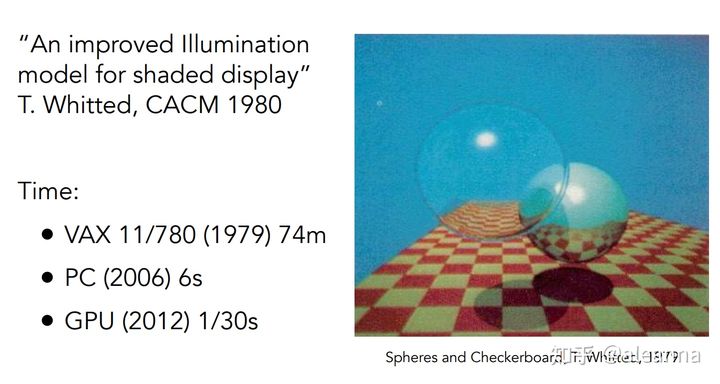
原理:
假设从相机的点(暂时不考虑透镜)出发,定义一个屏幕,对于屏幕的点的每一个像素发出一条光线,若不在阴影里,则计算光线每一交点的着色的值的和;

基础:
1.求解交点:
光线的数学公式定义:
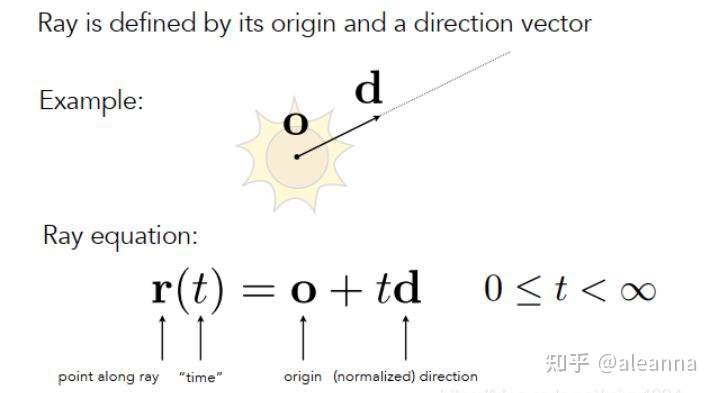
方法一:先求与平面的交点,再判断和三角形是否相交:相交方法可以查看另一篇文章文末代码:
当与三角形相交,对于t一定有解,并且t>=0
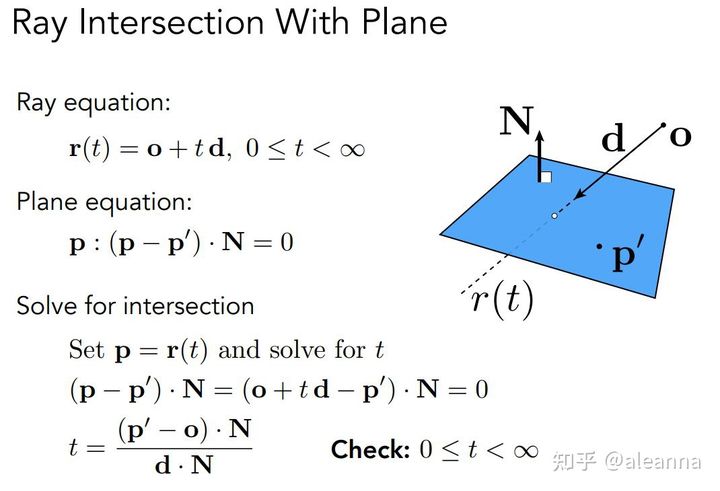
方法二:代入公式

步骤:
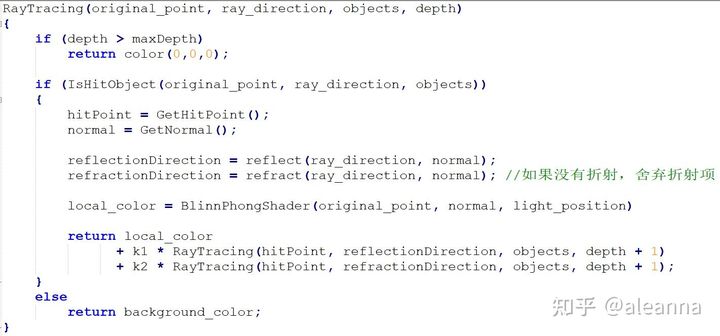
图片来自于参考
根据Code大概整理了一下思路:(还是有些不清楚的地方)
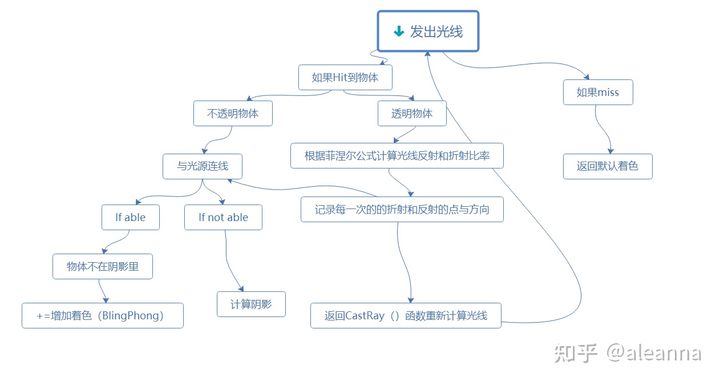
Whitted-style 不能解决的问题:
1.whitted-style 是完美的镜面反射,对于稍微有一些粗糙程度的镜面便不是这么精确。
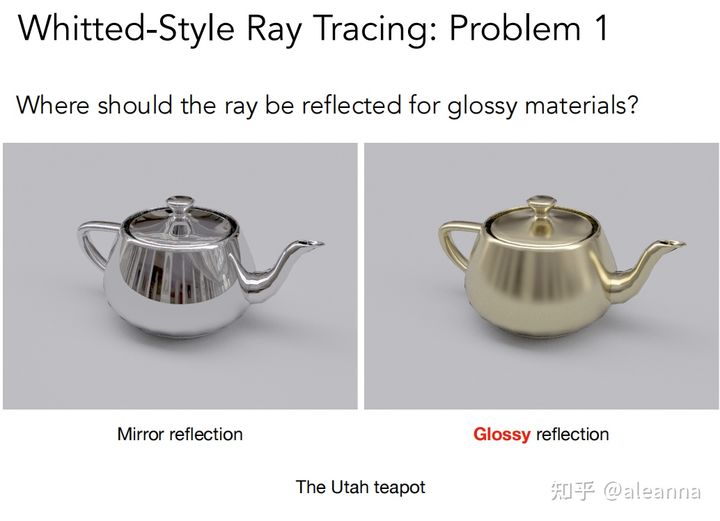
2.遇到漫反射物体会停止。而在下面这个康奈尔盒子中,漫反射的立方体应该会有来自墙面绿色和红色的反光。
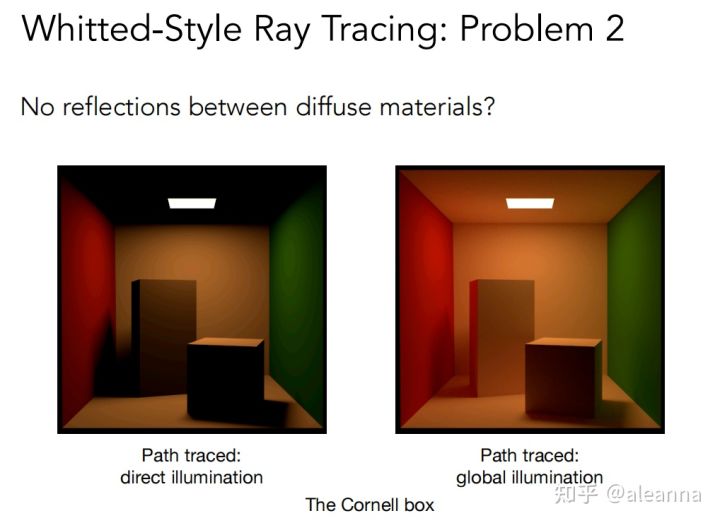
3.为了解决这些问题,需要引入更好的方式————路径追踪,下篇文章将会讲到。
主要函数主体如下:
// [comment]
// Implementation of the Whitted-style light transport algorithm (E [S*] (D|G) L)
//
// This function is the function that compute the color at the intersection point
// of a ray defined by a position and a direction. Note that thus function is recursive (it calls itself).
//
// If the material of the intersected object is either reflective or reflective and refractive,
// then we compute the reflection/refraction direction and cast two new rays into the scene
// by calling the castRay() function recursively. When the surface is transparent, we mix
// the reflection and refraction color using the result of the fresnel equations (it computes
// the amount of reflection and refraction depending on the surface normal, incident view direction
// and surface refractive index).
//
// If the surface is diffuse/glossy we use the Phong illumation model to compute the color
// at the intersection point.
// [/comment]
Vector3f castRay(
const Vector3f &orig, const Vector3f &dir, const Scene& scene,
int depth)//传入原点,方向,屏幕,深度
{
if (depth > scene.maxDepth) {
return Vector3f(0.0,0.0,0.0);
}
Vector3f hitColor = scene.backgroundColor;
if (auto payload = trace(orig, dir, scene.get_objects()); payload)
{
Vector3f hitPoint = orig + dir * payload->tNear;
Vector3f N; // normal
Vector2f st; // st coordinates
payload->hit_obj->getSurfaceProperties(hitPoint, dir, payload->index, payload->uv, N, st);
switch (payload->hit_obj->materialType) {
case REFLECTION_AND_REFRACTION:
{
Vector3f reflectionDirection = normalize(reflect(dir, N));
Vector3f refractionDirection = normalize(refract(dir, N, payload->hit_obj->ior));
Vector3f reflectionRayOrig = (dotProduct(reflectionDirection, N) < 0) ?
hitPoint - N * scene.epsilon :
hitPoint + N * scene.epsilon;
Vector3f refractionRayOrig = (dotProduct(refractionDirection, N) < 0) ?
hitPoint - N * scene.epsilon :
hitPoint + N * scene.epsilon;
//重新在hitPoint生成两条光线
Vector3f reflectionColor = castRay(reflectionRayOrig, reflectionDirection, scene, depth + 1);
Vector3f refractionColor = castRay(refractionRayOrig, refractionDirection, scene, depth + 1);
float kr = fresnel(dir, N, payload->hit_obj->ior);
hitColor = reflectionColor * kr + refractionColor * (1 - kr);
break;//
}
case REFLECTION:
{
float kr = fresnel(dir, N, payload->hit_obj->ior);
Vector3f reflectionDirection = reflect(dir, N);
Vector3f reflectionRayOrig = (dotProduct(reflectionDirection, N) < 0) ?
hitPoint + N * scene.epsilon :
hitPoint - N * scene.epsilon;
hitColor = castRay(reflectionRayOrig, reflectionDirection, scene, depth + 1) * kr;
break;
}
default:
{
// [comment]
// We use the Phong illumation model int the default case. The phong model
// is composed of a diffuse and a specular reflection component.
// [/comment]
Vector3f lightAmt = 0, specularColor = 0;
Vector3f shadowPointOrig = (dotProduct(dir, N) < 0) ?
hitPoint + N * scene.epsilon :
hitPoint - N * scene.epsilon;
// [comment]
// Loop over all lights in the scene and sum their contribution up
// We also apply the lambert cosine law
// [/comment]
for (auto& light : scene.get_lights()) {
Vector3f lightDir = light->position - hitPoint;
// square of the distance between hitPoint and the light
float lightDistance2 = dotProduct(lightDir, lightDir);
lightDir = normalize(lightDir);
float LdotN = std::max(0.f, dotProduct(lightDir, N));
// is the point in shadow, and is the nearest occluding object closer to the object than the light itself?
auto shadow_res = trace(shadowPointOrig, lightDir, scene.get_objects());
bool inShadow = shadow_res && (shadow_res->tNear * shadow_res->tNear < lightDistance2);
lightAmt += inShadow ? 0 : light->intensity * LdotN;
Vector3f reflectionDirection = reflect(-lightDir, N);
specularColor += powf(std::max(0.f, -dotProduct(reflectionDirection, dir)),
payload->hit_obj->specularExponent) * light->intensity;
}
hitColor = lightAmt * payload->hit_obj->evalDiffuseColor(st) * payload->hit_obj->Kd + specularColor * payload->hit_obj->Ks;
break;
}
}
}
return hitColor;
}
发出光线函数:
void Renderer::Render(const Scene& scene)
{
std::vector<Vector3f> framebuffer(scene.width * scene.height);
float scale = std::tan(deg2rad(scene.fov * 0.5f));
float imageAspectRatio = scene.width / (float)scene.height;
// Use this variable as the eye position to start your rays.
Vector3f eye_pos(0);
int m = 0;
for (int j = 0; j < scene.height; ++j)
{
for (int i = 0; i < scene.width; ++i)
{
// generate primary ray direction
float x;
float y;
// TODO: Find the x and y positions of the current pixel to get the direction
// vector that passes through it.
// Also, don't forget to multiply both of them with the variable *scale*, and
// x (horizontal) variable with the *imageAspectRatio*
float x = (2 * (i + 0.5) / (float)scene.width - 1) *imageAspectRatio * scale;
float y = (1 - 2 * (j + 0.5) / (float)scene.height) * scale;
Vector3f dir = normalize(Vector3f(x, y, -1));
Vector3f dir = Vector3f(x, y, -1); // Don't forget to normalize this direction!
framebuffer[m++] = castRay(eye_pos, dir, scene, 0);
}
UpdateProgress(j / (float)scene.height);
}
// save framebuffer to file
FILE* fp = fopen("binary.ppm", "wb");
(void)fprintf(fp, "P6\n%d %d\n255\n", scene.width, scene.height);
for (auto i = 0; i < scene.height * scene.width; ++i) {
static unsigned char color[3];
color[0] = (char)(255 * clamp(0, 1, framebuffer[i].x));
color[1] = (char)(255 * clamp(0, 1, framebuffer[i].y));
color[2] = (char)(255 * clamp(0, 1, framebuffer[i].z));
fwrite(color, 1, 3, fp);
}
fclose(fp);
}
与三角形求交:
bool rayTriangleIntersect(const Vector3f& v0, const Vector3f& v1, const Vector3f& v2, const Vector3f& orig,
const Vector3f& dir, float& tnear, float& u, float& v)
{
// TODO: Implement this function that tests whether the triangle
// that's specified bt v0, v1 and v2 intersects with the ray (whose
// origin is *orig* and direction is *dir*)
// Also don't forget to update tnear, u and v.
Vector3f E1 = v1 - v0;
Vector3f E2 = v2 - v0;
Vector3f S = orig - v0;
Vector3f S1 = crossProduct(dir,E2);
Vector3f S2 = crossProduct(S,E1);
float temp = dotProduct(E1,S1);
if(temp == 0 || temp <0)
return false;
u = dotProduct(S1,S)/temp;
v = dotProduct(dir,S2)/temp;
tnear = dotProduct(S2,E2)/temp;
if(u >= 0 && v >= 0 && tnear >= 0 && (1 - u -v) >= -__FLT_EPSILON__)
{
return true;
}
else{
//if(u >= 0 && v >= 0 && tnear >= 0 &&(1 - u -v) < 0)
//std::cout << u << v << tnear << std::endl;
return false;
}
}
其余函数:
#include <fstream>
#include "Vector.hpp"
#include "Renderer.hpp"
#include "Scene.hpp"
#include <optional>
inline float deg2rad(const float °)
{ return deg * M_PI/180.0; }
// Compute reflection direction
Vector3f reflect(const Vector3f &I, const Vector3f &N)
{
return I - 2 * dotProduct(I, N) * N;
}
// [comment]
// Compute refraction direction using Snell's law
//
// We need to handle with care the two possible situations:
//
// - When the ray is inside the object
//
// - When the ray is outside.
//
// If the ray is outside, you need to make cosi positive cosi = -N.I
//
// If the ray is inside, you need to invert the refractive indices and negate the normal N
// [/comment]
Vector3f refract(const Vector3f &I, const Vector3f &N, const float &ior)
{
float cosi = clamp(-1, 1, dotProduct(I, N));
float etai = 1, etat = ior;
Vector3f n = N;
if (cosi < 0) { cosi = -cosi; } else { std::swap(etai, etat); n= -N; }
float eta = etai / etat;
float k = 1 - eta * eta * (1 - cosi * cosi);
return k < 0 ? 0 : eta * I + (eta * cosi - sqrtf(k)) * n;
}
// [comment]
// Compute Fresnel equation
//
// \param I is the incident view direction
//
// \param N is the normal at the intersection point
//
// \param ior is the material refractive index
// [/comment]
float fresnel(const Vector3f &I, const Vector3f &N, const float &ior)
{
float cosi = clamp(-1, 1, dotProduct(I, N));
float etai = 1, etat = ior;
if (cosi > 0) { std::swap(etai, etat); }
// Compute sini using Snell's law
float sint = etai / etat * sqrtf(std::max(0.f, 1 - cosi * cosi));
// Total internal reflection
if (sint >= 1) {
return 1;
}
else {
float cost = sqrtf(std::max(0.f, 1 - sint * sint));
cosi = fabsf(cosi);
float Rs = ((etat * cosi) - (etai * cost)) / ((etat * cosi) + (etai * cost));
float Rp = ((etai * cosi) - (etat * cost)) / ((etai * cosi) + (etat * cost));
return (Rs * Rs + Rp * Rp) / 2;
}
// As a consequence of the conservation of energy, transmittance is given by:
// kt = 1 - kr;
}
// [comment]
// Returns true if the ray intersects an object, false otherwise.
//
// \param orig is the ray origin
// \param dir is the ray direction
// \param objects is the list of objects the scene contains
// \param[out] tNear contains the distance to the cloesest intersected object.
// \param[out] index stores the index of the intersect triangle if the interesected object is a mesh.
// \param[out] uv stores the u and v barycentric coordinates of the intersected point
// \param[out] *hitObject stores the pointer to the intersected object (used to retrieve material information, etc.)
// \param isShadowRay is it a shadow ray. We can return from the function sooner as soon as we have found a hit.
// [/comment]
std::optional<hit_payload> trace(
const Vector3f &orig, const Vector3f &dir,
const std::vector<std::unique_ptr<Object> > &objects)
{
float tNear = kInfinity;
std::optional<hit_payload> payload;
for (const auto & object : objects)
{
float tNearK = kInfinity;
uint32_t indexK;
Vector2f uvK;
if (object->intersect(orig, dir, tNearK, indexK, uvK) && tNearK < tNear)
{
payload.emplace();
payload->hit_obj = object.get();
payload->tNear = tNearK;
payload->index = indexK;
payload->uv = uvK;
tNear = tNearK;
}
}
return payload;
若有错误之处,希望谅解并欢迎指正。
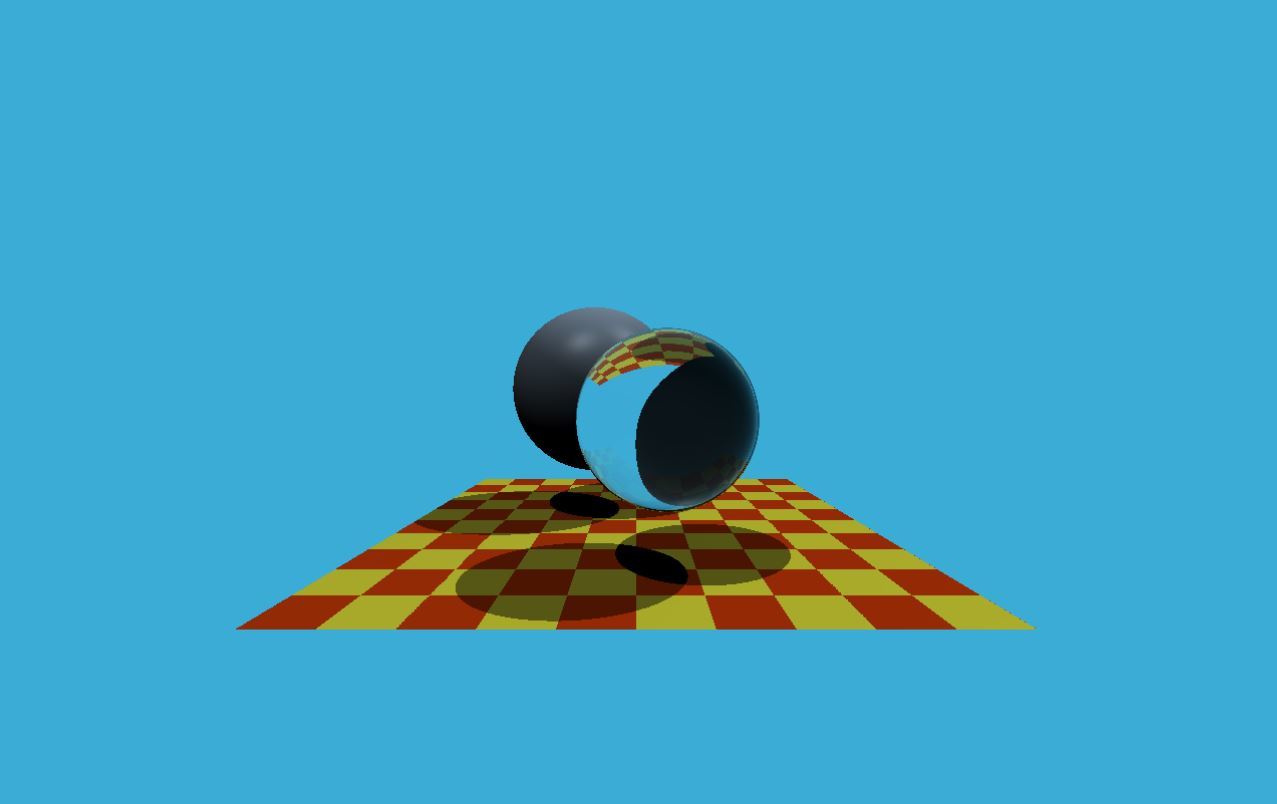
参考:
计算机图形学十二:Whitted-Style光线追踪原理详解及实现细节70 赞同 · 10 评论文章正在上传…重新上传取消
GAMES101_Lecture_13 (ucsb.edu)sites.cs.ucsb.edu/~lingqi/teaching/resources/GAMES101_Lecture_13.pdf
关于Fresel 反射与折射的文章:






















 1993
1993











 被折叠的 条评论
为什么被折叠?
被折叠的 条评论
为什么被折叠?








